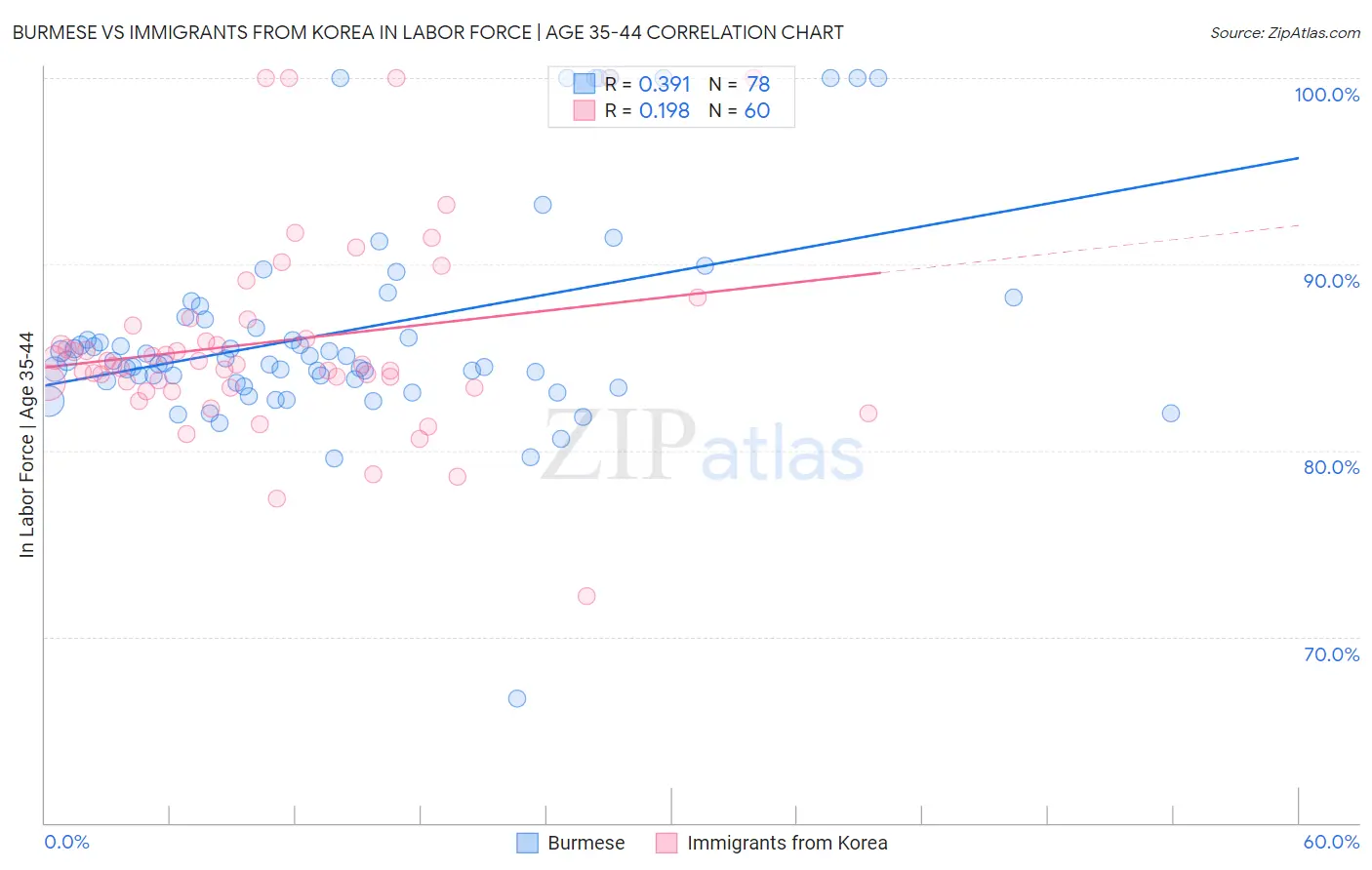Burmese vs Immigrants from Korea In Labor Force | Age 35-44
COMPARE
Burmese
Immigrants from Korea
In Labor Force | Age 35-44
In Labor Force | Age 35-44 Comparison
Burmese
Immigrants from Korea
84.7%
IN LABOR FORCE | AGE 35-44
91.8/ 100
METRIC RATING
119th/ 347
METRIC RANK
84.6%
IN LABOR FORCE | AGE 35-44
88.2/ 100
METRIC RATING
134th/ 347
METRIC RANK
Burmese vs Immigrants from Korea In Labor Force | Age 35-44 Correlation Chart
The statistical analysis conducted on geographies consisting of 464,995,533 people shows a mild positive correlation between the proportion of Burmese and labor force participation rate among population between the ages 35 and 44 in the United States with a correlation coefficient (R) of 0.391 and weighted average of 84.7%. Similarly, the statistical analysis conducted on geographies consisting of 416,059,040 people shows a poor positive correlation between the proportion of Immigrants from Korea and labor force participation rate among population between the ages 35 and 44 in the United States with a correlation coefficient (R) of 0.198 and weighted average of 84.6%, a difference of 0.060%.

In Labor Force | Age 35-44 Correlation Summary
| Measurement | Burmese | Immigrants from Korea |
| Minimum | 66.7% | 72.2% |
| Maximum | 100.0% | 100.0% |
| Range | 33.3% | 27.8% |
| Mean | 86.5% | 85.9% |
| Median | 84.8% | 84.6% |
| Interquartile 25% (IQ1) | 83.7% | 83.5% |
| Interquartile 75% (IQ3) | 87.2% | 86.9% |
| Interquartile Range (IQR) | 3.4% | 3.3% |
| Standard Deviation (Sample) | 5.9% | 5.5% |
| Standard Deviation (Population) | 5.8% | 5.4% |
Demographics Similar to Burmese and Immigrants from Korea by In Labor Force | Age 35-44
In terms of in labor force | age 35-44, the demographic groups most similar to Burmese are Immigrants from Northern Europe (84.7%, a difference of 0.0%), Immigrants from China (84.7%, a difference of 0.010%), Immigrants from Eastern Asia (84.7%, a difference of 0.010%), Finnish (84.7%, a difference of 0.010%), and German (84.7%, a difference of 0.010%). Similarly, the demographic groups most similar to Immigrants from Korea are Argentinean (84.6%, a difference of 0.0%), Immigrants from Malaysia (84.6%, a difference of 0.010%), Palestinian (84.7%, a difference of 0.020%), Bhutanese (84.7%, a difference of 0.020%), and Immigrants from Scotland (84.7%, a difference of 0.020%).
| Demographics | Rating | Rank | In Labor Force | Age 35-44 |
| Immigrants | Egypt | 92.7 /100 | #116 | Exceptional 84.7% |
| Immigrants | China | 92.3 /100 | #117 | Exceptional 84.7% |
| Immigrants | Eastern Asia | 92.1 /100 | #118 | Exceptional 84.7% |
| Burmese | 91.8 /100 | #119 | Exceptional 84.7% |
| Immigrants | Northern Europe | 91.5 /100 | #120 | Exceptional 84.7% |
| Finns | 91.2 /100 | #121 | Exceptional 84.7% |
| Germans | 91.0 /100 | #122 | Exceptional 84.7% |
| Immigrants | South America | 90.9 /100 | #123 | Exceptional 84.7% |
| Slavs | 90.8 /100 | #124 | Exceptional 84.7% |
| Maltese | 90.8 /100 | #125 | Exceptional 84.7% |
| Asians | 90.6 /100 | #126 | Exceptional 84.7% |
| Immigrants | Spain | 90.6 /100 | #127 | Exceptional 84.7% |
| Immigrants | Ghana | 90.4 /100 | #128 | Exceptional 84.7% |
| Palestinians | 89.7 /100 | #129 | Excellent 84.7% |
| Bhutanese | 89.7 /100 | #130 | Excellent 84.7% |
| Immigrants | Scotland | 89.6 /100 | #131 | Excellent 84.7% |
| Austrians | 89.4 /100 | #132 | Excellent 84.7% |
| Argentineans | 88.4 /100 | #133 | Excellent 84.6% |
| Immigrants | Korea | 88.2 /100 | #134 | Excellent 84.6% |
| Immigrants | Malaysia | 87.5 /100 | #135 | Excellent 84.6% |
| Afghans | 86.3 /100 | #136 | Excellent 84.6% |